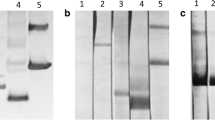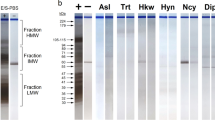Abstract
Wolbachia are intracellular α-proteobacteria, closely related to Rickettsia, that infect various arthropods and filarial parasites. In the present study, the cDNA encoding the aspartate aminotransferase (AspAT) of Wolbachia from the human pathogenic filarial parasite Onchocerca volvulus (Ov-WolAspAT) was identified. At the amino acid level, the identity of the Ov-WolAspAT was 56% to Rickettsia prowazekii AspAT and 54% to the AspAT of the nitrogen-fixing bacterium Sinorhizobium meliloti, but the highest degree of identity was found to the putative AspAT of Wolbachia from Brugia malayi and Drosophila melanogaster (85%). All of these bacterial AspATs are members of the AspAT subclass Ib. A 35 kDa fragment of the Ov-WolAspAT was expressed in Escherichia coli, and immunolocalization using polyclonal antibodies against this antigen revealed that Ov-WolAspAT is present in a considerable proportion of the Wolbachia from O. volvulus, as well as in the endobacteria of several other filarial parasites. Western blot analysis using recombinant Ov-WolAspAT as antigen showed that IgG1 antibodies were present in 70 (51%) individuals living in areas endemic for O. volvulus, B. malayi or Wuchereria bancrofti and no IgG4 or IgE antibodies were found. Among 40 sera of persons from Uganda and Liberia who were putatively not infected with human filarial parasites, 11 (28%) individuals presented IgG1 antibodies, while none of the 33 sera from healthy Europeans and none of the 14 sera from patients with proven Rickettsia or Brucella infections reacted with the antigen. These results also show that an intracellular protein of Wolbachia endobacteria (WolAspAT) acts as antigen in human filariasis.



Similar content being viewed by others
References
Albiez EJ, Gallin M, Erttmann KD, Racz P, Büttner DW (1985) Characteristics of chronic severe onchodermatitis in Liberia. J Liberian Med Dent Assoc 15:120–125
Andersson SG, Zomorodipour A, Andersson JO, Sicheritz-Pontén T, Alsmark UC, Podowski RM, Näslund AK, Eriksson AS, Wincler HH, Kurland CG (1998) The genome sequence of Rickettsia prowazekii and the origin of mitochondria. Nature 396:133–140
Bandi C, Anderson TJ, Genchi C, Blaxter ML (1998) Phylogeny of Wolbachia in filarial nematodes. Proc R Soc Lond B Biol Sci 265:2407–2413
Bandi C, McCall JW, Genchi C, Corona S, Venco L, Sacchi L (1999) Effects of tetracycline on the filarial worms Brugia pahangi and Dirofilaria immitis and their bacterial endosymbionts Wolbachia. Int J Parasitol 29:357–364
Bazzocchi C, Ceciliani F, McCall JW, Ricci I, Genchi C, Bandi C (2000a) Antigenic role of the endosymbionts of filarial nematodes: IgG response against the Wolbachia surface protein in cats infected with Dirofilaria immitis. Proc R Soc Lond B Biol Sci 267:2511–2516
Bazzocchi C, Jamnongluk W, O'Neill SL, Anderson TJ, Genchi C, Bandi C (2000b) Wsp gene sequences from the Wolbachia of filarial nematodes. Curr Microbiol 41:96–100
Beg MA, Fistein JL, Ingram GA, Storey DM (1996) Activities of glycogen phosphorylase, alanine aminotransferase and aspartate aminotransferase in adult worms of Litomosoides carinii recovered from pyridoxine deficient cotton rats (Sigmodon hispidus). Parasitology 112:227–232
Brattig NW, Krawietz I, Abakar AZ, Erttmann KD, Kruppa TF, Massougbodji A (1994) Strong IgG isotypic antibody response in sowdah type onchocerciasis. J Infect Dis 170:955–961
Brattig NW, Rathjens U, Ernst M, Geisinger F, Renz A, Tischendorf FW (2000) Lipopolysaccharide-like molecules derived from Wolbachia endobacteria of the filaria Onchocerca volvulus are candidate mediators in the sequence of inflammatory and antiinflammatory responses of human monocytes. Microbes Infect 2:1147–1157
Brattig NW, Büttner DW, Hoerauf A (2001) Neutrophil accumulation around Onchocerca worms and chemotaxis of neutrophils are dependent on Wolbachia endobacteria. Microbes Infect 3:439–446
Casiraghi M, Anderson TJ, Bandi C, Bazzocchi C, Genchi C (2001a) A phylogenetic analysis of filarial nematodes: comparison with the phylogeny of Wolbachia endosymbionts. Parasitology 122:93–103
Casiraghi M, Favia G, Cancrini G, Bartoloni A, Bandi C (2001b) Molecular identification of Wolbachia from the filarial nematode Mansonella ozzardi. Parasitol Res 87:417–420
Cooper AJ, Meister A (1985) Metabolic significance of transamination. In: Metzler C (ed) Transaminases. Wiley, New York, pp 533–563
Davies KP, Köhler P (1990) The role of amino acids in the energy generating pathways of Litomosoides carinii. Mol Biochem Parasitol 41:115–124
Dreyer G, Piessens WF (2000) Worms and microorganisms can cause lymphatic disease in residents of filariasis-endemic areas. In: Nutman TB (ed) Lymphatic filariasis. Imperial College Press, London, pp 245–264
Fischer P, Kipp W, Bamuhiga J, Binta-Kahwa J, Kiefer A, Büttner DW (1993) Parasitological and clinical characterization of Simulium neavei-transmitted onchocerciasis in western Uganda. Trop Med Parasitol 44:311–321
Fischer P, Supali T, Wibowo H, Bonow I, Williams SA (2000) Detection of DNA of nocturnally periodic Brugia malayi in night and day blood samples by a polymerase chain reaction-ELISA-based method using an internal control DNA. Am J Trop Med Hyg 62:291–296
Henkle-Dührsen K, Eckelt VH, Wildenburg G, Blaxter M, Walter RD (1998) Gene structure, activity and localization of a catalase from intracellular bacteria in Onchocerca volvulus. Mol Biochem Parasitol 96:69–81
Hoerauf A, Nissen-Pähle K, Schmetz C, Henkle-Dührsen K, Blaxter ML, Büttner DW, Gallin MY, Al-Qaoud KM, Lucius R, Fleischer B (1999) Tetracycline therapy targets intracellular bacteria in the filarial nematode Litomosoides sigmodontis and results in filarial infertility. J Clin Invest 103:11–18
Hoerauf A, Volkmann L, Hamelmann C, Adjei O, Autenrieth IB, Fleischer B, Büttner DW (2000a) Endosymbiotic bacteria in worms as targets for a novel chemotherapy in filariasis. Lancet 355:1242–1243
Hoerauf A, Volkmann L, Nissen-Pähle K, Schmetz C, Autenrieth I, Büttner DW, Fleischer B (2000b) Targeting of Wolbachia endobacteria in Litomosoides sigmodontis: comparison of tetracyclines with chloramphenicol, macrolides and ciprofloxacin. Trop Med Int Health 5:275–279
Hoerauf A, Mand S, Adjei O, Fleischer B, Büttner DW (2001) Depletion of Wolbachia endobacteria in Onchocerca volvulus by doxycycline and microfilaridermia after ivermectin treatment. Lancet 357:1415–1416
Hussain R, Ottesen EA (1986) IgE responses in human filariasis. IV. Parallel antigen recognition by IgE and IgG4 subclass antibodies. J Immunol 136:1859–1863
Isola LM, Zhou SL, Kiang CL, Stump DD, Bradbury MW, Berk PD (1995) 3T3 fribroblasts transfected with a cDNA for mitochondrial aspartate aminotransferase express plasma membrane fatty acid-binding protein and saturable fatty acid uptake. Proc Natl Acad Sci U S A 92:9866–9870
Jeyaprakash A, Hoy MA (2000) Long PCR improves Wolbachia DNA amplification: wsp sequences found in 76% of sixty-three arthropod species. Insect Mol Biol 9:393–395
Keiser PB, Reynolds SM, Awadzi K, Ottesen EA, Taylor MJ, Nutman TB (2002) Bacterial endosymbionts of Onchocerca volvulus in the pathogenesis of posttreatment reactions. J Infect Dis 185:805–811
Koszarski A (1999) Clonierung und Charakterisierung eines potentiellen Endobakterien-Hitzeschockproteins aus Onchocerca volvulus Leuckart. PhD thesis, Faculty of Biology, University of Hamburg, Hamburg
Kugler P (1993) Enzymes involved in glutamatergic and GABAergic neurotransmission. Int Rev Cytol 147:285–336
Kurniawan-Atmadja A, Sartono E, Partono F, Yazdanbakhsh M, Maizels R (1998) Specificity of predominant IgG4 antibodies to adult and microfilarial stages of Brugia malayi. Parasite Immunol 20:155–162
Langworthy NG, Renz A, Mackenstedt U, Henkle-Dührsen K, de Bronsvoort MB, Tanya VN, Donnely MJ, Trees AJ (2000) Macrofilaricidal activity of tetracycline against the filarial nematode Onchocerca ochengi: elimination of Wolbachia precedes worm death and suggests a dependent relationship. Proc R Soc Lond B Biol Sci 267:1063–1069
Mpagi JL, Büttner DW, Tischendorf FW, Erttmann KD, Brattig NW (2000) Use of the recombinant Onchocerca volvulus protein Ov20/OvS1 for the immunodiagnostic differentiation between onchocerciasis and mansonelliasis and for the characterization of hyperreactive onchocerciasis (sowda). Trop Med Int Health 5:891–897
Nobe Y, Kawaguchi S, Ura H, Nakai T, Hirotsu K, Kato R, Kuramitsu S (1998) The novel substrate recognition mechanism utilized by aspartate aminotransferase of the extreme thermophile Thermus thermophilus HB8. J Biol Chem 273:29554–29564
Ottesen EA, Skvaril F, Tripathy SP, Poindexter RW, Hussain R (1985) Prominence of IgG4 in the IgG antibody response to human filariasis. J Immunol 134:2707–2712
Papadimitriou JM, van Duijn P (1970) The ultrastructural localization of the isozymes of aspartate aminotransferase in murine tissues. J Cell Biol 47:84–98
Parkinson J, Whitton C, Guiliano D, Daub J, Blaxter ML (2001) 200,000 nematode expressed sequence tags on the net. Trends Parasitol 17:394–396
Punkosdy GA, Dennis VA, Lasater BL, Tzertzinis G, Foster JM, Lammie PJ (2001a) Detection of serum IgG antibodies specific for Wolbachia surface protein in rhesus monkeys infected with Brugia malayi. J Infect Dis 184:385–389
Punkosdy GA, Addiss DG, Lammie PJ (2001b) Is there a relationship between antibody response to Wolbachia surface protein and the development of lymphoedema and hydrocele in persons with lymphatic filariasis. Am J Trop Med Hyg 65 [Suppl]:161
Saint Andre A, Blackwell NM, Hall LR, Hoerauf A, Brattig NW, Volkmann L, Taylor MJ, Ford L, Hise AG, Lass JH, Diaconu E, Pearlman E (2002) The role of endosymbiontic Wolbachia bacteria in the pathogenesis of river blindness. Science 295:1892–1895
Schulz-Key H, Karam M (1986) Periodic reproduction of Onchocerca volvulus. Parasitol Today 2:284–286
Sun LV, Foster JM, Tzertzinis G, Ono M, Bandi C, Slatko BE, O'Neill SL (2001) Determination of Wolbachia genome size by pulsed-field gel electrophoresis. J Bacteriol 183:2219–2225
Supali T, Wibowo H, Rückert P, Fischer K, Ismid IS, Purnomo, Djuardi Y, Fischer P (2002) High prevalence of Brugia timori infection in the highland of Alor island, Indonesia. Am J Trop Med Hyg 66:560–565
Taylor MJ, Hoerauf A (1999) Wolbachia bacteria of filarial nematodes. Parasitol Today 15:437–442
Taylor MJ, Cross HF, Bilo K (2000) Inflammatory responses induced by the filarial nematode Brugia malayi are mediated by lipopolysaccharide-like activity from endosymbiotic Wolbachia bacteria. J Exp Med 191:1429–1436
Watson RJ, Rastogi VK (1993) Cloning and nucleotide sequencing of Rhizobium meliloti aminotransferase genes: an aspartate aminotransferase required for symbiotic nitrogen fixation is atypical. J Bacteriol 175:1919–1928
Williams SA, Lizotte-Waniewski MR, Foster J, Guiliano D, Daub J, Scott AL, Slatko B, Blaxter ML (2000) The filarial genome project: analysis of the nuclear, mitochondrial and endosymbiont genomes of Brugia malayi. Int J Parasitol 30:411–419
Acknowledgements
We wish to thank I. Albrecht for expert technical assistance. For supplying patients' sera and parasite material, we thank G. Bretzel, T. Supali, A. Hoerauf, D.B. Copeman, M. Omar, P. Racz, A. Renz, A. Plenge-Bönig and H. Schulz-Key. We are indebted to S.A. Williams and the members of the Filarial Genome Project for making data on filarial genomes public. Preliminary sequence data on Drosophila WolAspAT was obtained from the Institute for Genomic Research website (http:/tigrblast.tigr.org/ufmg/). P. Fischer was supported by the scholarship program "Infectiology" of the German "Bundesministerium für Bildung und Forschung". New nucleotide sequence data reported in this paper are available in the GenBank database under the accession numbers AF411604, AF412405 and AF412406.
Author information
Authors and Affiliations
Corresponding author
Rights and permissions
About this article
Cite this article
Fischer, P., Bonow, I., Büttner, D.W. et al. An aspartate aminotransferase of Wolbachia endobacteria from Onchocerca volvulus is recognized by IgG1 antibodies from residents of endemic areas. Parasitol Res 90, 38–47 (2003). https://doi.org/10.1007/s00436-002-0813-2
Received:
Accepted:
Published:
Issue Date:
DOI: https://doi.org/10.1007/s00436-002-0813-2




